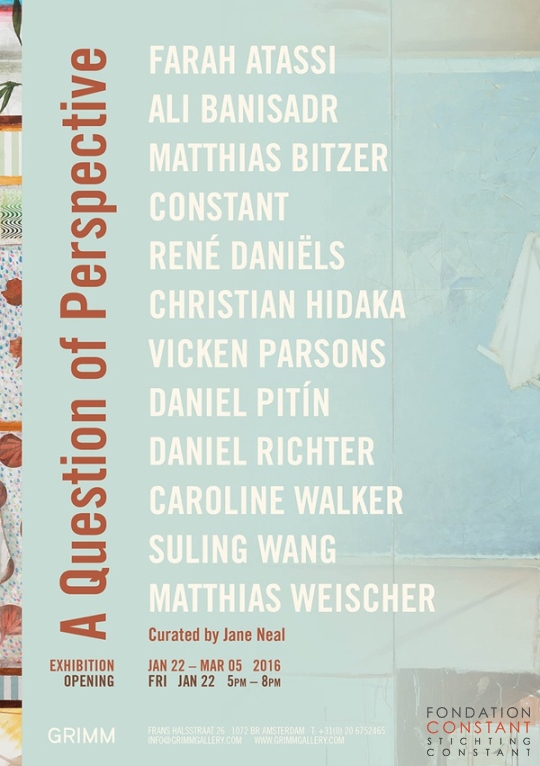Image


1698
A Question of Perspective
Farah Atassi (BE, 1981) | Ali Banisadr (IR, 1976) | Matthias Bitzer (DE, 1975)
Constant (NL, 1920-2005) | René Daniëls (NL, 1950) | Christian Hidaka (JP, 1977)
Vicken Parsons (UK, 1957) | Daniel Pitín (CZ, 1977) | Daniel Richter (DE, 1962)
Caroline Walker (UK, 1982) | Suling Wang (TW, 1968) | Matthias Weischer (DE, 1973)
GRIMM is pleased to present: A Question of Perspective. Curated by Jane Neal, the exhibition seeks to create a platform where painters: Farah Atassi, Matthias Bitzer, Constant, René Daniëls, Christian Hidaka, Vicken Parsons,Daniel Pitín, Daniel Richter, Caroline Walker, Suling Wang and Matthias Weischer, bring fresh perspectives on the representation of space and question art's relationship to time, from distinct and different positions.
Our perception of space, our engagement with space, and through it, our interaction with each other, has never been more pertinent as a topic for exploration. Just as the adoption of perspective as a means of representing reality became synonymous with how Europe positioned itself with a view to the rest of the world in the 15th Century and beyond, so our attempts to rethink this use of perspective in art, could have a profound effect on what happens in our age, and in the future.
We are all bound by pre-conceived notions, by our own and others' expectations and by rules we accept and adhere to, often without question. Time and space are not excepted: these two dimensions have been measured and boxed into systems and formulae that we can quantify, and - to a certain extent - manage and control. In Western art history, the artist's relationship to time and space has been intrinsically linked to art's evolution; nowhere is this more evident than in the practice of painting.
There is a strong case for suggesting that in order for painting to progress and for painters to really 'break' the stranglehold of perspective - not only on the canvas itself (this might be a battle ground but it's not the whole war), but in the minds of both artist - and viewer - artists need to look beyond the established canon. The painters in this exhibition have deliberately chosen to look outside of the Western tradition, or sought to combine different ways of engaging with and representing space. Suling Wang has been inspired by her native Taiwan and Chinese painting traditions; Christian Hidaka has looked to Japan and China, but also to Cubism and to the masters of the early 20th Century; Matthias Weischer has been influenced by his experience of drawing 'en plein air', in western gardens, but also by the experience of spending ! time drawing in Leipzig's hidden gem: a Japanese garden tucked away in the heart of the city; Ali Banisadr has looked to his Persian ancestry. He cites the work of Kamal al-din Bihzad as particularly remarkable: "His miniatures are constructed in such a way as to force the eye to keep moving around the picture plane, without finding a permanent resting place."
Considering the nature of our global world, it is nonsensical to operate within the confines of the prescribed traditions of Western art history, without considering what the East might contribute - not only in terms of offering an alternative approach to mathematical perspective, but with regards to our perspective on what art and being an artist is. If ever there was an art for our global age, then painting - in all its visceral plasticity, is the medium that allows for the greatest diversity and for the full incorporation of new and alien ideas, while simultaneously expanding according to the repetition and evolution of established forms.
It is also important that modern and contemporary media and technologies, and their impact on painting - especially in terms of how artists see space - are not ignored. Cinema has had a profound influence. This is especially apparent when we consider the work of Caroline Walker and Daniel Pitín. Both these artists rely on our 'collective database' of imagery, and on familiarity with certain iconic scenarios and genres, such as the crime drama, and on the ability of the viewer to be 'play detective' in order to understand the often complex physical and psychological spaces created by the artists.
Artists today, working 'post internet' have the privilege (and the weight) of the largest data base of images at their fingertips - often in their studios, via their laptops and tablets. The means to collage, to play with different spatial constructions and to suspend time, all on one pictorial ground, using paint, the most plastic of languages, has opened up an almost endless number of possibilities for artists' exploration, and communication. It was David Hockney who perhaps understood this better than anyone: "The space between where you end and I begin, is the most interesting space of all. It's far more interesting than outer space. It's all about me, looking. That's what any picture is, an account of looking at something."
- Jane Neal London, 2015
No related items available
No related items available
No related items available
No related items available
No related items available
| Title | Year |
|---|---|
| Happening | 1973 |
No related items available
No related items available